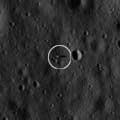The moon mapping, photographs to human remains

It has been 40 years since man first came to the Moon, and more news, news and issues are heard on this issue of the usual. Well, the commemorative events of the anniversary have coincided in time with the first results of the probe sent by NASA for the elaboration of the mapping of the Moon.
Just a month ago it began to orbit around the Moon and has already sent the first photos that NASA's LRO (Lunar Reconnaissance Orbiter) probe made to the modules of the Apollo missions. Specifically, it has detected five of the six lunettes made, including that of the Eagle module, which in the mission Apollo 11 led Armstrong, Collins and Aldrin to the surface of the Moon. Sunlight has taken pictures when the Moon played with a very small angle, which has made the location of the modules much more evident, as they show a great shade.
NASA has announced that the LRO probe will still be closer to the Moon and that the photographs of the surface of the Moon will have a resolution between two and three times greater. The final objective of this mission is to make a cartography as accurate as possible of the Moon to determine where to ilargar in future expeditions to the Moon, measure the amount of radiation it receives, etc.
Image: Image: In the large image you can see the Eagle module of the Apollo 11 mission in the image taken by the LRO probe on the surface of the Moon. In the small image, on the surface of the Moon, image of Adrini taken by Armstrong together with Eagle (Photos: Handia, NASA/Goddard Space Flight Center/Arizona, Small State University, NASA/Neil Armstrong)
Buletina
Bidali zure helbide elektronikoa eta jaso asteroko buletina zure sarrera-ontzian











